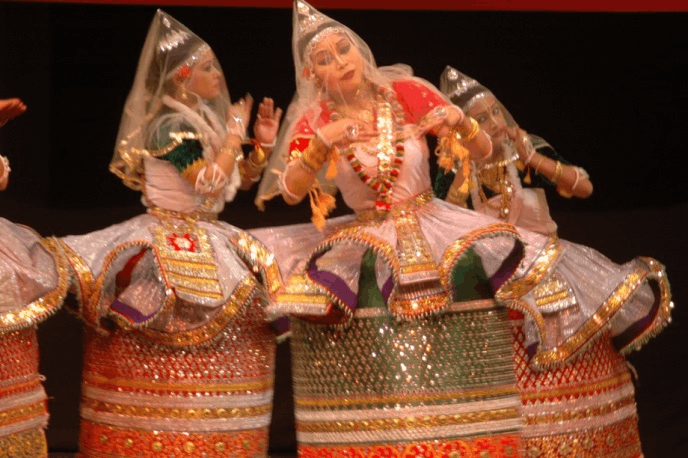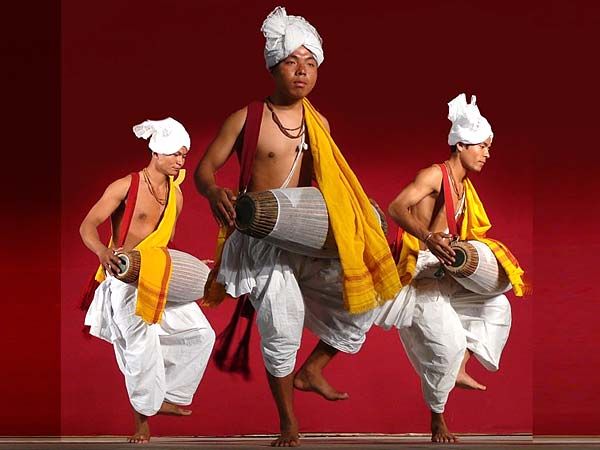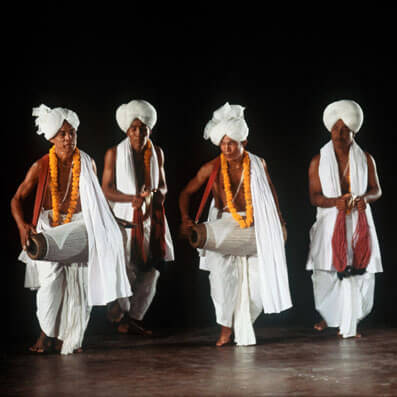Rasa Nritya is a classical one and it is of gentle form (Tandava). The dance dramas are interpreted by a male narrator. Thabal Chongba, Laiharaoba, Khamba Thoibi, Kortal Cholom, Maibee Jagoi, Pung Cholom (Mridanga Dance) dances are popular in the valley. Rongmei Naga dance, Mao Naga dance, Thangal Surung dance, Anal Naga dance, Lengmei Naga dance, Kuki Bamboo dance, Lushai Kholam dance, Tarao’s Trao dance, etc are practiced in the Hills of Manipur.
Nurtured for centuries, dance in India has evolved in different parts of the country its own distinct style, taking on the culture of that particular region, each acquiring its own flavour. Consequently, a number of major styles of ‘art’ dance are known to us today, like Bharatnatyam, Kathakali, Kuchipudi, Kathak, Manipuri and Odissi. Then there are regional variations, the dances of rural and tribal areas, which range from simple, joyous celebrations of the seasons, harvest or birth of a child to dances for the propitiation of demons or for invoking spirits. Today, there is also a whole new body of modern experimental dance.
Lai Haraoba is the earliest form of dance which forms the basis of all stylised dances in Manipur. Literally meaning — the merry-making of the gods, it is performed as a ceremonial offering of song and dance. The principal performers are the maibas and maibis (priests and priestesses) who re-enact the theme of the creation of the world. With the arrival of Vaishnavism in the 15th century A.D, new compositions based on episodes from the life of Radha and Krishna were gradually introduced. It was in the reign of King Bhagyachandra that the popular Ras Leela dances of Manipur originated. It is said, that this 18th century philosopher king conceived this complete dance form along with its unique costume and music in a dream. Under successive rulers, new leelas, and rhythmic and melodic compositions were introduced.
Manipuri dance has a large repertoire, however, the most popular forms are the Ras, the Sankirtana and the Thang-ta. There are five principal Ras dances of which four are linked with specific seasons, while the fifth can be presented at any time of the year. In Manipuri Ras, the main characters are Radha, Krishna and the gopis. The themes often depict the pangs of separation of the gopis and Radha from Krishna. The parengs or pure dance sequences performed in the Ras Leela dances follow the specific rhythmic patterns and body movements, which are traditionally handed down. The Ras costume consists of a richly embroidered stiff skirt which extends to the feet. A short fine white muslin skirt is worn over it. A dark coloured velvet blouse covers the upper part of the body and a traditional white veil is worn over a special hair-do which falls gracefully over the face. Krishna wears a yellow dhoti, a dark velvet jacket and a crown of peacock feathers. The jewellery is very delicate and the designs are unique to the region.
The Kirtan form of congregational singing accompanies the dance which is known as Sankirtana in Manipur. The male dancers play the Pung and Kartal while dancing. The masculine aspect of dance — the Choloms are a part of the Sankirtana tradition.The Pung and Kartal choloms are performed at all social and religious festivals. The martial dancers of Manipur — the Thang-ta, have their origins in the days when man’s survival depended on his ability to defend himself from wild animals. Today, Manipur has an evolved and sophisticated repertoire of martial dances, the dancers use swords, spears and shields. Real fight scenes between the dancers show an extensive training and control of the body. Manipuri dance incorporates both the tandava and lasya and ranges from the most vigorous masculine to the subdued and graceful feminine.




